by admin | Nov 16, 2021 | Uncategorized |
How your pelvis ‘sits’ within your body can have a huge impact on the capacity to:
- Move well.
- Transfer forces through the spine.
- Support the internal and pelvic organs.
- Breathe well.
- Maintain the tone of all the muscles (that’s 72 in total) , amongst many other factors.
I think of the Pelvis as being like the Spaghetti Junction of the body. It’s in the middle and everything travels through it. All muscles are at their strongest/most supportive when they are at their optimum position. Given how many muscles attach and have an influence on the pelvis, we can start to see how a change in one area can start to have an impact on other areas.
Therefore, pelvic alignment important for everyone but it can be a particularly important area to address if you are experiencing back pain, pelvic organ prolapse, urinary leakage, diastasis recti or any other symptoms that make you think twice or stop you from doing the things you love.
Where do you put your pelvis?
To help you find the positioning of your pelvis, I want you to identify if you ‘tip’ or ‘tuck’.
- Place the heels of your hands on the hip bones (anterior superior iliac spine – ASIS) and your fingertips on the Pubis Symphasis (PS).
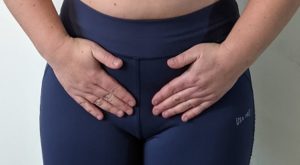
- Does it feel like the PS is behind the ASIS (tipping – anterior tilt).
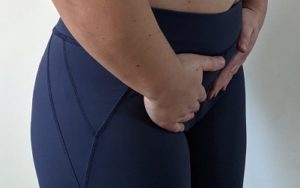
- Or, does it feel like the PS is in front of the ASIS (tucking – posterior tilt) – I don’t do this very well. It’s not my pattern.
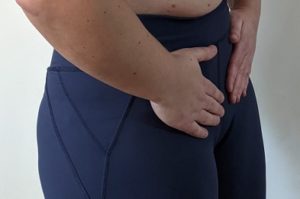
- Tip your pelvis forwards and backwards (you may need to soften your knees to achieve this). You should feel the PS move backwards and forwards in relation to the ASIS. Pause when you feel like the ASIS and the PS are level with each other. This is neutral and the positioning we are aiming for on a more consistent unconscious basis. Does feel easy or hard for you to be in that position? Does it feel comfortable or alien to your body?
What do these positions mean for our bodies?
If you found you were tucking your pelvis under …
When the pelvis tucks under (known as a Posterior Tilt) the pelvis is drawn backwards and downwards. This position can increase the tension in the muscles at the back of your legs and pelvic floor. When in this position over a prolonged time, the buttocks may develop a flattened look as it is more difficult to engage them effectively from this position. Not great for Pelvic Organ Prolapse or incontinence symptoms.
If you found that you were tipping your pelvis forward ….
When the pelvis tips forward (known as an Anterior Tilt) the pelvis is drawn forwards and down. The position can increase the tension in the muscles at the front of the hips and legs. This pulls on the abdominal muscles that attach to the top of the pelvis making it harder for them to engage, manage intra-abdominal pressure and support the spine. Not great for a Diastasis Recti.
How to achieve a more beneficially consistent position for your Pelvis?
Bringing greater awareness is the first step important when it comes to maintaining the integrity of our core. Now that you are aware of the position your Pelvis prefers to rest in you can introduce more of the opposite into your day. Notice if you have gone into a tipping or tucking pelvis position when you’re stood talking to a friend or waiting in a queue, or sat a work and ‘re-find’ neutral.
Introducing mobility and strengthening exercises can be used to bring balance back to the muscles and the best thing is that once our bodies know how to achieve them we can incorporate them into our daily exercise, which help continue to support the body.
If you want to find out more about how you can address the subject of this blog just get in touch. Let me know what’s going on for you and we can have a chat about how I can help.
by admin | Nov 9, 2021 | Uncategorized
How well the ‘core’ works is integral to so many aspects of our whole wellbeing, not just preventing back pain and ‘oops’ moments, although it is pretty great at doing those things and there is nothing a bit of discomfort to motivate us to make a change. After all that is all the body is asking for when it offers us these symptoms.
In these cases redeveloping ‘core strength’ can be really helping in improving the situation. However, not all ‘core strengthening’ is created equal. To coin a phrase “it ain’t what you do, it’s the way that you do it…. that’s what gets results”.
There is an important distinction to be made between ‘core exercise’ and ‘core training.’ Core exercise involves doing a sets of repetitions of exercises often in isolation. It doesn’t necessarily consider if the exercises are contributing to the functionality of the entire body. This is not necessarily ‘bad’ but not beneficial if the body is already under strain.
On the other hand, ‘core training’, addresses functionality in the whole body. It includes your breathing, your muscles, your existing patterns of engagement, resting tension and how you put all of that together (particularly when you moving) to establish a synergistic relationship throughout the body.
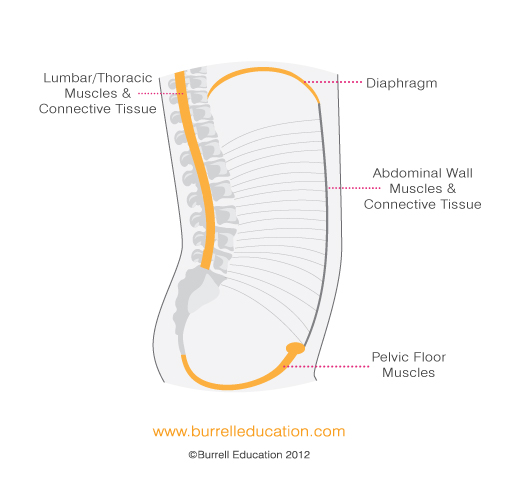
When addressing symptoms of core dysfunction its important to look at ‘core training’ as it incorporates the Reflexive Core. This is the inner most part of the core system and is represented in the diagram below. Our respiratory diaphragm is at the top of the balloon and the pelvic floor muscles are at the bottom of the balloon. These muscles are mirror images of each other. The deep abdominal muscles wrap around connecting back to the front and the top and the bottom.
When all parts of the ‘core’ work well together they engage with each other and are able to automatically respond to our movements and changes in pressure e.g. sneezing, coughing, jumping, lifting, running, etc. However, this inner group of muscles can be effected by the outer muscles in this area impacting on their capacity to work together. So, whilst we want to support a certain area, we take a whole body approach to the redevelopment of ‘Core Strength’ to help the body to return to how it was designed to work.
If you’d like help to resolve any ‘Core’ issues (such as pelvic floor problems, diastasis recti/tummy gap), recurring back or pelvis pain that you may be experiencing feel free to reply to this email and I’ll let you know how I can help.
by admin | Nov 1, 2021 | Uncategorized |
Does it really matter how you breathe? In a word – yes. It can matter greatly where core and pelvic floor dysfunction is concerned.
Breathing is not something we really think about. In the main it’s an unconscious process. But the fact that we breathe 20,000 times a day surely means that it deserves to be executed well. When done well, it delivers the maximum results to our health and can prevent core dysfunction.
However, it’s not uncommon for those experiencing symptoms of core and pelvic floor dysfunction to have breathing patterns that are not optimal to how the body works.
To explain why we should be breathing from our ribs and not from our bellies, I’m going to explain a bit about what’s going on inside of us. Understanding how our bodies have been designed to work will help you visualise what’s going on and empower you to use your breath more efficiently.
What happens when we breathe? / How should breathing happen?
When we breathe in, the respiratory muscles moves the rib cage in (ideally) 3 directions. This decreases the pressure in the lungs which draws the air in. When the respiratory diaphragm moves downwards during inhalation it increases pressure in the abdomen. To manage that pressure the abdomen changes shape. This can appear like the tummy is expanding, however, the abdomen can’t really do that – more on that below. What is actually happening is the abdominal wall is passively resisting the change in shape, which assists in the exhalation of the air.
So, what if we do breathe from our belly?
It’s not uncommon for people to adopt a pattern of belly breathing. If you were to belly breathe the muscles of your abdominal wall are actively moved when you breath in, rather than passively moving in response to the expansion of the ribs.
The belly has been designed to change shape but not to expand unless it’s full of food or liquid, or there’s a baby inside. It’s not designed to change shape with every breath. So, if the muscles of the abdomen are actively moving it will bulge increasing the pressure in the abdomen.
As pressure always follows the line of least resistance, a bulge in the belly caused by this increase in pressure may move forward onto the Linea Alba, not great for a Diastasis. This action may cause a weakening of the front line which will reduce the integrity of your core function. Should the pressure go downwards, it may put excess pressure on the pelvic organs, and this could be part of the picture of pelvic organ prolapse.
The benefits of breathing from your ribs
So, now you know just a couple of negative things that can happen to your health should you ever fall into the habit of belly breathing, let’s move on to rib breathing and celebrate the benefits that this brings us!
- It keeps the ribs and thoracic mobile.
- Helps maintain bone density against osteoporosis and fractures.
- It supports the management of intra-abdominal pressure.
- It creates negative pressure in the pelvic and abdominal cavity on the exhale, creating a passive lift and toning of the pelvic floor muscles.
- It releases tension from the shoulders as the thoracic spine moves with every inhale, almost like your very own massage with every breath. Amazing!
Simple ways to find if you are a belly breather
Lie on your back with one hand resting on your chest and the other on your tummy.
Allow yourself to relax and breathe normally. Start to notice which hand moves first when you inhale.
Ideally the hand on your ribs move first, followed by your hand on your belly. On the exhale the hand on the tummy lowers first followed by the hand on the ribs. If you notice the hand on your tummy moving first you may be belly breathing.
If you feel you could benefit from finding out what your breathing patterns are and whether making changes could help you to support your core and pelvic floor function, feel free to get in touch with me at info@ormskirkpilates.co.uk. In my ‘Do More 4 Your Core’ programme we use a series of techniques to address different breathing patterns to make them more optimal for resolving symptoms of core and pelvic floor dysfunction.
by admin | Oct 25, 2021 | Uncategorized |
I’m a firm believer that knowledge is power. To regain control of your body and get back to doing the activities you love, knowing how the body works can really help in understanding the reasons behind WHY certain routes to recovery are recommended and being able to embody the changes needed.
Often we lose connection with our bodies developing habits that are not facilitative to how our ‘Core’ works for us. It’s not surprising really. The ‘core’ is an area of the body that should work for us without us having to think about it. Our ‘core’ should be REFLEXIVE i.e. able to actively support our bodies during different activities.
Let’s take a deeper look in order to understand how your Core should work for you
Think of your Core like an inflated balloon
In the image you can see the representation of the ‘Core’.
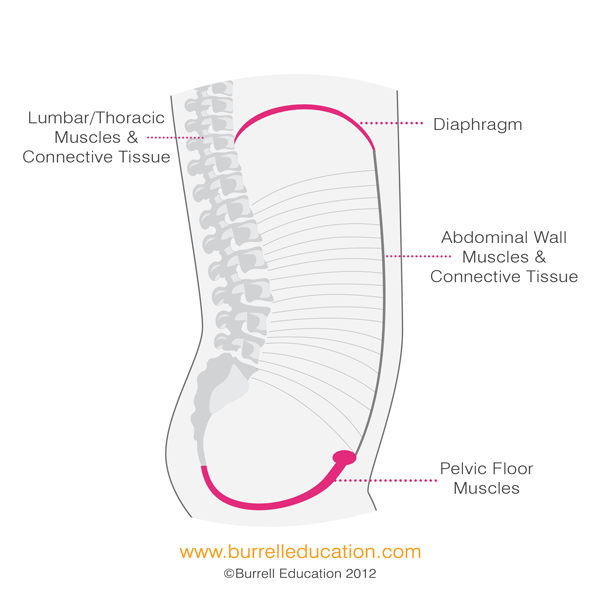
Our respiratory diaphragm is at the top of the balloon and the pelvic floor muscles are at the bottom of the balloon. These muscles are mirror images of each other. The deep abdominal muscles wrap around the centre of the balloon connecting the top and the bottom.
Imagine that your ‘core’ takes the shape of this balloon. The skin of the balloon represents three sets of muscles: our respiratory diaphragm, our deep abdominal muscles, and our pelvic floor muscles. All three muscles work together and manage the pressure that naturally exists in the abdomen.
When all aspects within that imaginary balloon work well together they engage with each other and are able to respond to our movements correctly and changes in pressure e.g. sneezing, coughing, jumping, lifting, running, etc, automatically. This is our ‘Reflexive Core’ system working as it is designed to do.
How do we know if the Core is working Reflexively?
When the ‘Core’ is not supporting our bodies effectively we can go on to develop symptoms. These can include:
• Urinary incontinence. These are the embarrassing involuntary leaks.
• Urinary urgency. An intense urge to wee – not always accompanied by urination.
• Urinary frequency. Needing a wee more than 7 times a day and you may need to visit the bathroom during the night too.
• Pelvic organ prolapse. A feeling of heaviness/pressure into the pelvis or vagina.
• Bowel changes. Needing to use the toilet urgently and/or frequency or suffering from constipation.
• Pain. This can be experienced in the pelvis, lower back, hip, perineum, c-section scar area and during intercourse.
What disrupts the core from working reflexively?
Here are 9 of the most common reasons why our core struggles to be reflexive.
• A diastasis recti or tummy tap. This is a separation down the middle of the abdomen/balloon.
• A c-section or perineal scar tissue. This can disrupt the flow of information through the ‘core’ reducing the elasticity of the tissues resulting in the inner balloon being less flexible.
• Underactive pelvic floor muscles. This is when the pelvic floor muscles become too weak to hold the bottom of the balloon leaving them unable to respond to pressure change.
• Overactive pelvic floor muscles. This is when the pelvic floor muscles are too tight and have lost their elasticity. This weakness prevents them from generating any pressure change and stops them from coordinating with other core muscles.
• Constantly holding in the tummy. By holding in your tummy, you are forcing the pressure changes downwards onto the pelvic organs. This squeezes the middle of the balloon causing the top and the bottom to bulge.
• Breathing from your belly. Belly breathing cause the belly to bulge and increases pressure in the abdomen. Pressure finds the path of least resistance, usually downwards (pelvic organs) or abdomen which can weaken the lining of the balloon.
• Changes in postural alignment. Poor posture disrupts the optimum body alignment i.e. ribs over pelvis. This reduces ‘core’ communicating effectively with each other.
• Movement patterns and habits. The way we move, and exercise, impacts the effectiveness of our core. While exercising is assumed to always be good for us, when done incorrectly, it can have the opposite effect and if you were to develop, and repeat, poor techniques you can over time cause more harm than good.
• Hormone changes. Never ever underestimate the power of our hormones! As we enter different life stages our hormone levels shift and this has an impact on the tissues that support the core muscles.
Taking a whole body training approach will keep your core healthy
To reduce and resolve any symptoms of core dysfunction you need to identify the fault and find a way to correct it. However, this cannot be done in isolation of the whole body. Assessing, addressing, and treating the body as a whole is key to experiencing a long lasting and sustainable resolution to your symptoms.
If you’d like help learning more about how you can address your symptoms feel free to email me at info@ormskirkpilates.co.uk.
by admin | Oct 21, 2021 | Uncategorized |
Your body is under constant pressure from its external environment and what’s going on inside it. And this pressure is necessary – it keeps your blood circulating and your digestion moving. In relation to having good ‘core function’, the pressure we’re interested in is Intra Abdominal Pressure (IAP). Anyone who experiences core and pelvic floor issues tends to have habits that place excess pressure in the system.
So, just where is this pressure?
The deep muscles of your core encase the abdominal cavity. Their job is to house your visceral organs: the liver, stomach, spleen, digestive tract, kidneys, and pelvic organs. There’s pressure within the abdominal cavity, a bit like an inflated balloon – this is the IAP.
How does the core manage IAP?
The main job of your core function is to manage IAP on a daily basis.
When you breathe in the diaphragm contracts and flattens downwards, this increases IAP. In order to maintain IAP, the pelvic floor and abdominal wall muscles lengthen under load just like the bed of a trampoline does when someone lands on it.
When you breathe out the diaphragm returns to its resting position creating a recoil on the pelvic floor and abdominal wall muscles returning them to their resting position too.
This process maintains consistent pressure within the abdomen. It also helps it to manage coughs and sneezes amongst many activities that increase the IAP. If all the parts aren’t working well together then we many notice that the management needs some improvement when put under high pressure.
What factors can improve IAP management?
Mobility: Stiffness, tension, and tightness anywhere in the body will have a knock-on effect elsewhere. When we lack movement in one area, it will be taken from another. Movement in the pelvis, spine, and ribcage are essential to good core function.
Stop Belly Breathing: The abdominal muscles are designed to assist breathing. If the tummy muscles are ‘doing’ the work, they are creating more IAP. Just think what happens to the air inside a balloon when you squeeze it. This pushes pressure forward or down which long-term can compromise the muscles and supporting ligaments, tendons, and fascia.
Stop Holding Your Stomach In: Resisting the natural movement in the abdomen increases IAP. This time restriction forces the pressure downwards on to the pelvic floor. The core is also designed to work reflexively. Holding the stomach in stops this from happening. Without reflexive ability we cannot have core stability.
Improve Postural Patterns: The core works best when the diaphragm and pelvic floor are positioned directly above and below each other. Often our postural habits change this alignment.
Core Engagement Strategy: How we engage our core also has an impact on how pressure is managed. For a variety of reasons, we may have developed the habit of bulging, bracing, or bearing down as a strategy to support the core. All of these direct the pressure where we don’t want it. Teaching the core to work more reflexively will support core function.
The power of the breath when restoring core function
Good strength and flexibility of the pelvic floor and abdominal wall muscles are essential in restoring core function.
It’s important to be aware that most training techniques generate greater IAP when performed. If IAP is not managed well at optimal pressure, performing ‘core strength’ exercises such as sit-ups or planks can make your symptoms worse.
The best way to restore good core function is to start with the breath. This will help manage IAP and can make a big difference to resolving symptoms of core dysfunction.
In our ‘Do More 4 Your Core’ programme we’ll help you create optimal breathing patterns that improve muscle tone through a training method that incorporates a specialised breathing technique to reduce the IAP.
To learn more about the courses I run, or to simply ask a question, feel free to email me at info@ormskirkpilates.co.uk.
by admin | Oct 19, 2021 | Uncategorized |
Improving ‘core strength’ is one of the main reasons why folks get in touch with me. Health professionals often advise their patients to ‘strengthen their core’ as part of their pain relief rehabilitation. But I often feel a there is a disparity between what I understand as being ‘the core’, and what is considered to be ‘core strength’.
Pop ‘core strength’ into Google images and you’ll see lots of pictures of people with low body fat and developed muscles, usually doing sit up and planks.
Don’t get me wrong, these are great exercises, but they might not be the right exercises if you are experiencing any pain and discomfort, or pelvic floor dysfunction. That’s because when you experience these uncomfortable symptoms the ‘core’ is not functioning well, it’s NOT because the ‘core’ is inherently weak.
So, I’m making it my mission to spread the word about what good core function actually is so you can get the right help for you to support your body.
So, let’s take a quick look at what good core function really is:
Core function is the capacity for the constituent parts of the ‘core’ to work together to perform the natural chain reaction of expansion (inhaling) and compression (exhaling) optimally.
The 3 main constituents to focus on are:
- Your respiratory diaphragm. This is the large muscle that’s situated at the base of your lungs, its job is to give us the power to breathe efficiently.
- Your Transverse Abdominus. This is the muscle that wraps around your middle, a bit like a corset.
- Your pelvic diaphragm. This is just a posh word for the muscles of your pelvic floor.
When these guys work well together the ‘core’ works reflexively, i.e. it turns on and off as needed to support your body as you go about your daily activities. All these components are driven by the breath. One of the ways to develop good core function is to address breathing strategies.
The more you focus on the 3 main constituents of core function the better they will work together. And when they work together well, they’ll help you with these everyday functions:
- Better breathing = increased feelings of wellbeing.
- Allowing movement of the trunk.
- Spare the spine from excessive loads.
- Transfer forces between the upper and lower parts of the body.
- Facilitate better digestion.
- Enable the expulsion/excretion of waste substances.
- Support and protect the internal organs of the body.
To learn more about the course I run, or to simply ask a question, feel free to email me at info@ormskirkpilates.co.uk.






Recent Comments